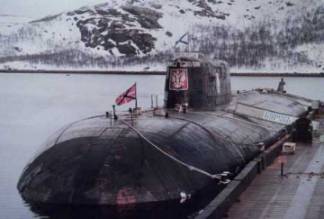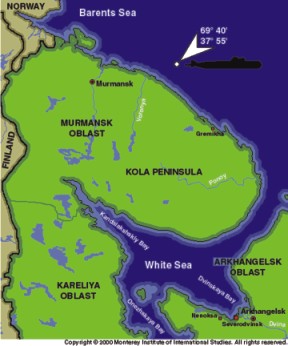
[At left: The Russian nuclear submarine Kursk, shown at a Navy base in Vidyayevo in May. Photo courtesy of www.aeronautics.ru]
| Geotimes Home | Calendar | Classifieds | Subscribe | Advertise |
| Geotimes
Published by the American Geological Institute |
January
2001
Newsmagazine of the Earth Sciences |
 Forensic
seismology
Forensic
seismology
Forensic scientists have pieced together evidence to help explain what caused one of Russia’s most advanced cruise-missile submarines to sink on Aug. 12, killing its crew of 118 sailors. The mystery surrounding the sinking of the Kursk began to unravel when photos of the vessel on the sea floor revealed that the periscope was still in the up position, indicating that disaster struck the heavily armed Oscar II class submarine within 20 meters of the surface. Two minutes and 15 seconds elapsed between two seismically recorded explosions related to the disaster — a lengthy time interval that puzzled seismologists.
[At right: image from the Center for Nonproliferation Studies (CNS) at the Monterey Institute of International Studies]
“The time span between the two events, 135 seconds, is plenty long enough for the Kursk to have sunk and then sat on the sea floor for a while before exploding [again],” says Keith Koper of the University of Arizona. Combining reported evidence with seismic observations, Koper, Terry Wallace of the University of Arizona and scientists from Los Alamos National Laboratory in New Mexico presented plausible disaster scenarios during the San Francisco meeting of the American Geophysical Union on Dec. 15.
Since the accident, a number of theories have circulated, including that an American sub watching the Kursk’s training exercise collided with the Russian sub. But, Koper says, “the seismic signals of the two Kursk events are very similar, implying similar source mechanisms.” The second event created a seismic signal as well as a high frequency bubble signature that would follow an underwater explosion. “Since we know that the second [big] event was an explosion, this implies that the first [small] event was also an explosion and not a collision with another vessel.”
The submarine’s presence near the surface, combined
with confirmed reports that the Kursk radioed for permission to
fire and sink a barge, suggest a torpedo misfire or a premature detonation
caused the first explosion. “All the compartments were clean open,” Wallace
adds. “This remains a mystery.” The U.S. Navy requires that a submarine’s
compartments be closed when it fires a torpedo. As a result, the sub sank
fast. “It would have taken only 90 seconds for it to fill with water,”
he adds.

[At left: The Russian
nuclear submarine Kursk, shown at a Navy base in Vidyayevo in May.
Photo courtesy of www.aeronautics.ru]
Modern torpedoes carry warheads with the equivalent of 250 kilograms of high explosive, “easily large enough to accommodate the size of the first explosion,” the scientists reported. This was the Northern Fleet’s largest naval exercise in over a decade and “there is no reason to believe that live warheads were not present,” Wallace says, discounting earlier reports. “The firing was at a barge that was to be sunk — and they were using live ordinance the first day of the exercise.” Still, he adds, “250 kilograms is a little high for a torpedo, but possible. Most are 100 or 150 kilograms.”
During the poster presentation in San Francisco, Wallace explained that the Kursk might have been doomed if the “highly explosive liquid propellant” for the torpedo caught on fire. The first explosion created a magnitude-2.2 seismic event — small, but enough to start a reaction that could breach the double-hulled submarine and send it 80 to 100 meters to the bottom, he says.
The second explosion devastated the sub with 250 times more power than the first, creating a magnitude-4.2 event that was recorded as far as 5,000 kilometers away at stations in Africa, Wallace says. The seismic recordings show no sign of the impact of the sub on the marshy sea floor. Instead the seismic waveforms recorded a strong bubble pulse signature characteristic of an underwater explosion of approximately 3-7 tons of TNT. As the air trapped in the sub burst into the water column the rising bubble of hot gases oscillated in response to the changing hydrostatic pressure confining it.
Fire from the earlier torpedo explosion reaching one of the Kursk’s cruise missiles may be a likely explanation, the researchers say. A cruise missile tipped with a conventional 750-kilogram High Explosive warhead could create the same signal, as could multiple explosions of the smaller-yield ship-to-ship missiles if they exploded within .05 seconds of each other. In comparison with above-ground explosions, the Oklahoma bombing was equivalent to about 2 tons of TNT while the 1998 truck bombing of the U.S. embassy in Nairobi yielded about 3 tons TNT equivalent.
Christina Reed
Posted Jan. 23, 2001. This story will also appear in the February 2001 print issue of Geotimes.
 |
Geotimes Home | AGI Home | Information Services | Geoscience Education | Public Policy | Programs | Publications | Careers |